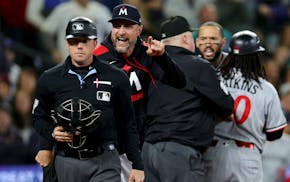Minnesota's licensing and permitting system for outdoor recreation — everything from bobcat-trapping to Nordic skiing on state trails — will undergo an electronic transformation next year to offer the convenience of mobile phone displays and on-the-go registrations.
Old-school paper certificates for fishing and other pursuits still will be an option, according to the Department of Natural Resources, but the new digital system bought from a private vendor will handle some 2.3 million license transactions per year. The new system also will issue about 550,000 boat, snowmobile and other recreational vehicle titles. Together, the permissions generate annual revenue for the state in excess of $100 million.
"This will get us into the 21st century," said DNR Fish and Wildlife Director Dave Olfelt. "We think people are really going to be appreciative."
State park reservations and admissions won't be part of the electronic licensing system, but hunters, anglers, trappers, state trail users and boaters will want to pay attention to changes before the system is launched in March 2025. The change in culture and technology was accepted by the Legislature this month as part of a larger natural resources policy bill. Gov. Tim Walz signed it Friday.
Olfelt said DNR stakeholders, including elected officials, have been pushing the agency to develop the same type of mobile system available to outdoors enthusiasts in other states. "We were hearing it loudly," Olfelt said. "Our current system is long in the tooth."
In one notable change, deer hunters no longer will attach harvest tags to the whitetails they shoot. Instead, they'll register their kills electronically. If the harvest occurs beyond the range of internet signals, they'll still be able to enter their harvest data into an electronic form that will upload automatically when a signal returns.
For boat, snowmobile and recreational vehicle registrations, people still will need to apply stickers to their equipment, but trail passes will be stored on users' phones. Printing a paper copy of various permits and licenses also will be acceptable.
Jenna Covey, the DNR's chief business technology officer, said the agency still is tweaking the system but will be demonstrating it to deputy registrars and other partners over the coming months. It also won't be long before the general public starts hearing about the change in promotions and marketing efforts.
"As the summer goes along, we'll be talking more and more about the changes coming," she said.
Time to catch up
Work on the new electronic licensing system began in 2021. In a survey of people who buy outdoors permits and licenses in Minnesota, the DNR learned that more than 80% of respondents strongly wanted a mobile application to store and display their privileges. DNR's conservation enforcement division has been involved in developing the new system.
"I would definitely say Minnesota is behind most other states," Covey said.
Under the existing system, hunters, anglers and others have been able to photograph their paper licenses and show those mobile phone pictures to inquiring conservation officers. But starting next year, those privileges will be coded into users' phones much like modern concert tickets and game tickets.
The new online system will offer a catalog of about 400 DNR licensing products. An example of the potential convenience would be that of a pheasant hunter getting off work in St. Cloud late on a Friday night and buying a properly stamped small game license via mobile phone while en route to a rural rooster hunt Saturday morning in southern Minnesota.
Still, Covey and Olfelt said Minnesotans won't lose the option of buying licenses over-the-counter at sporting goods stores, registrar offices, bait shops, gas stations, hardware stores or other outlets.
"We know we have people who have no access or it's part of their tradition to go to a certain place to buy their license," Olfelt said.
The DNR expects to spend about $3.5 million on the project, from 2021 through June 2025, Olfelt said. The agency is counting on new funding from the Legislature to cover three-fourths, including fiscal year 2024-25 expenses for a project risk assessment, user-acceptance testing, training and post-implementation support.
Covey said the DNR has been following a state of Minnesota "playbook" in developing the new system to avoid the major failures and service disruptions encountered during the failed build-out of a new motor vehicle licensing and registration system before COVID-19.
State Legislative Auditor Judy Randall in 2019 concluded that the Department of Public Safety and Office of Minnesota Information Technology Services shared responsibility for wasting $100 million over nine years on a system that didn't work.
Covey said a major lesson from that debacle was not to build an electronic licensing system from scratch. Instead, the DNR shopped for an off-the-shelf system and settled on one from PayIt Outdoors, a private U.S. vendor based in Kansas City.
PayIt Outdoors already operates hunting and fishing licensing systems for natural resources departments in Arkansas, Michigan, Ohio and Ontario. Covey said PayIt's installation in Minnesota will be heavily patterned after the other systems, with a certain amount of customization. She said the company doesn't get paid until the system is handling transactions.

Neal: Girma returns to United States national team and rewards fans with her classiness

Twins' Correa ejected from on-deck circle, and he's not really sure why

Twins' inability to score in extra innings costly in wild loss at Seattle

USWNT shuts out China 3-0 at Allianz Field

